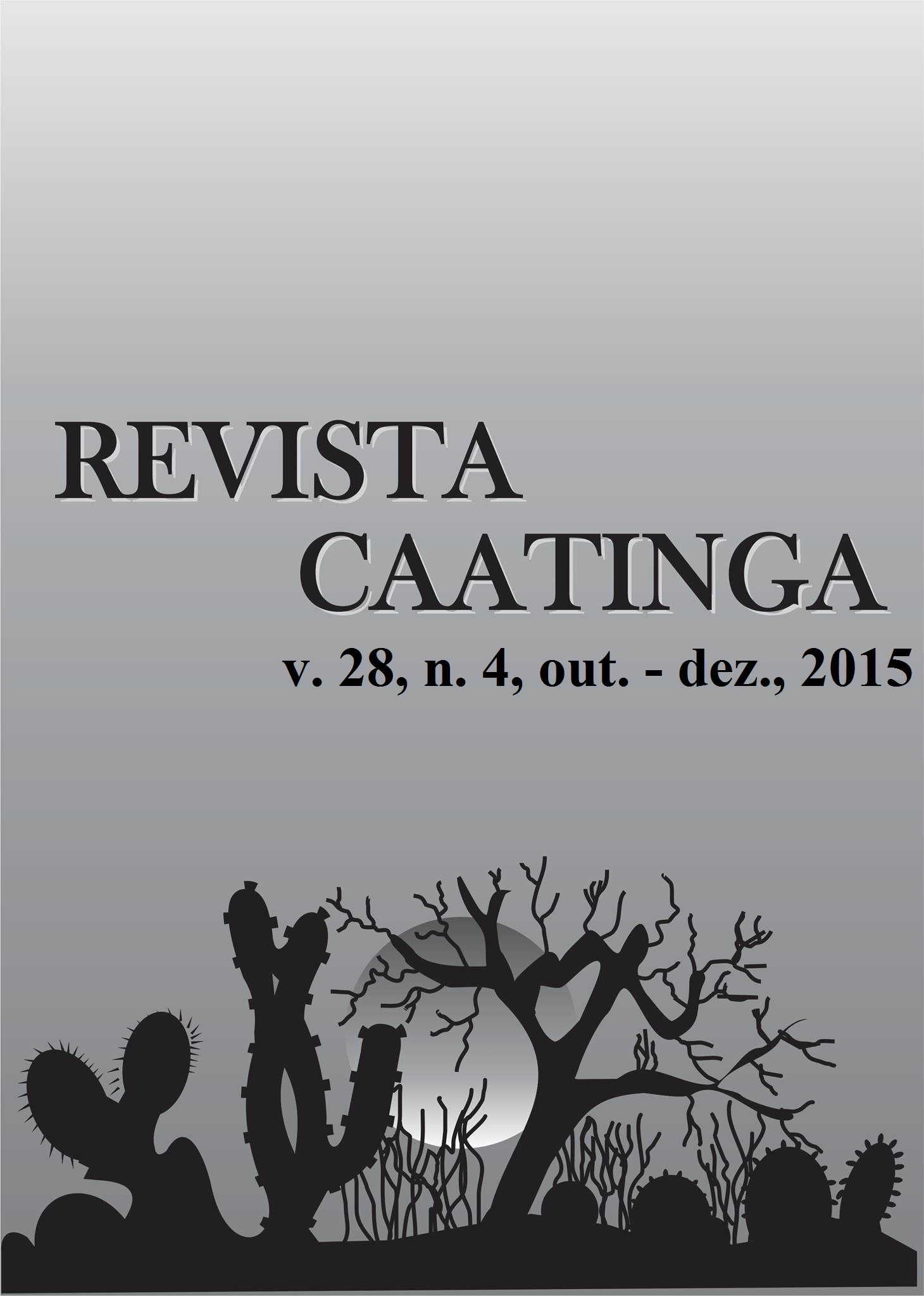DWARFISM OCCURRENCE IN TOMATO PLANT TYPE GRAPE
DOI:
https://doi.org/10.1590/1983-21252015v28n429rcKeywords:
Solanum lycopersicum L. Gene d (Dwarf). Inheritance. Allele. Mutation.Abstract
The phenotypic manifestations of genetic knowledge of important agronomic traits in plants is an activity of great importance, whose results are widely used in plant breeding. The objective was to study the type of genetic segregation that occurs when crossing a dwarf genotype versus indeterminate growth habit genotype. Their plant was found growing spontaneously in Piracicaba (SP), on-site disposal of fruits per tomatoes producers along with normal plants. Seeds of both plants were harvested separately for baseline and coded as follows: a plant with a normal phenotype (FN) and plant with atypical phenotype with characteristics of dwarfism (FA). The methodology consisted of biparental and reciprocal backcrosses of the F1 to the parent FA and obtained the F2 generation. The data derived from the plant count populations obtained (F1, F2 and backcrosses) were tested using the χ2 according to the expected frequency and observed the normal phenotype (FN) and plant with atypical phenotype with characteristics of dwarfism (FA), under the hypothesis Mendelian segregation 3:1, obtained by monogenic inheritance. From the results, it can be concluded that the phenotype observed in the plant in this study is recessive genetic origin can be inserted into other plants by crossing.Downloads
References
ANDRADE, M. C. et al. Capacidade combinatória de linhagens de tomateiro em híbridos do tipo italiano. Bragantia, Campinas, v. 73, n. 3, p. 237-245, 2014.
BUENO, L. C. S.; MENDES, A. N. G.; CARVALHO, S. P. Melhoramento Genético de Plantas: princípios e procedimentos. 2 ed. Lavras, MG: UFLA, 2006. 319 p.
CAMPOS, M. L. et al. Brassinosteroids interact negatively with jasmonates in the formation of anti-herbivory traits in tomato. Journal of Experimental Botany, Piracicaba, v. 60, n. 15, p. 4347-4361, 2009.
FILGUEIRA, F. A. R. Novo manual de Olericultura: Agrotecnologia moderna na produção e comercialização de hortaliças. 3 ed. Viçosa, MG: UFV, 2008. 421 p.
LIMA, J. E. et al. Callus, shoot and hairy root formation in vitro as affected by the sensitivity to auxin and ethylene in tomato mutants. Plant Cell Reports, Piracicaba, v. 28, n. 8, p. 1169-1177, 2009.
MACIEL, G. M.; SILVA, E. C. Herança do formato do fruto em tomateiro do grupo cereja. Horticultura Brasileira, Brasília, v. 26, n. 4, p. 495-498, 2008.
MAO, L. et al. JOINTLESS is a MADS-box gene controlling tomato flower abscission zone development. Nature, Londres, v. 406, n. 6798, p. 910-913, 2000.
MATSUKURA, C. et al. Generation of gamma irradiation-induced mutant lines of the miniature tomato (Solanum lycopersicum L.) Micro-Tom. Plant Biotechnology, Tokyo, v. 24, n. 1, p. 39-44, 2007.
MONTEIRO C. C. et al. Biochemical and histological characterization of tomato mutants. Anais da Academia Brasileira de Ciências, Rio de Janeiro, v. 84, n. 2, p. 573-585, 2012.
NADHZIMOV, U. K. et al. Growth and gibberellin relations of the extreme dwarf dx mutant. Physiologia Plantarum, Copenhagen, v. 73, n. 2, p. 252-256, 1988.
NIZIO, D. A. C. et al. Caracterização de genótipos de tomateiro resistentes a begomovírus por marcador molecular co-dominante ligado ao gene Ty-1. Pesquisa Agropecuária Brasileira, Brasília, v. 43, n. 12, p. 1699-1705, 2008.
PÉREZ S.; AHMED A. I. S.; CABEZAS D. Molecular and biochemical characterization of tomato (Solanum lycopersicum L.) plants cv. Micro-Tom under lead (Pb)-induced stress. Biotecnología Aplicada, La Habana, v. 30, n. 3,p. 194-198, 2013.
PIOTTO, F. A.; PERES, L. E. P. Base genética do hábito de crescimento e florescimento em tomateiro e sua importância na agricultura. Ciência Rural, Santa Maria, v. 42, n. 11, p. 1941-1946, 2012.
REID, J. B. Plant hormone mutants. Journal of Plant Growth Regulation, New York, v. 12, n. 4, p. 207-226, 1993.
REITER, W. D.; CHAPPLE, C. C. S.; SOMERVILLE, C. R. Altered growth and cell walls in a fucose-deficient mutant of Arabidopsis. Science, New York, v. 261, n. 5124, p. 1032-1035, 1993.
SILVA, A. C. et al. Root growth of tomato seedlings intensified by humic substances from peat bogs. Revista Brasileira de Ciência do Solo, Viçosa, v. 35, n. 5, p. 1609-1617, 2011.
TAKAHASHI, T. et al. The diminuto gene of Arabidopsis is involved in regulating cell elongation. Genes Development, New York, v. 9, n. 1, p. 97-107, 1995.
WANG, H. et al. The tomato Aux/IAA transcription factor IAA9 is involved in fruit development and leaf morphogenesis. Plant Cell, Rockville, v. 17, n. 10, p. 2676-2692, 2005.
WATANABE, S. et al. Ethylmetha nesulfonate (EMS) mutagenesis of Solanum lycopersicum cv. Micro-Tom for large scale mutant screens. Plant Biotechnology, Tokyo, v. 24, n. 1, p. 33-38, 2007.
ZSOGON, A. et al. Reduced arbuscular mycorrhizal colonization in tomato ethylene mutants. Scientia Agricola, Piracicaba, v. 65, n. 3, p. 259-267, 2008.
Downloads
Published
Issue
Section
License
Os Autores que publicam na Revista Caatinga concordam com os seguintes termos:
a) Os Autores mantêm os direitos autorais e concedem à revista o direito de primeira publicação, com o trabalho simultaneamente licenciado sob a Licença Creative Commons do tipo atribuição CC-BY, para todo o conteúdo do periódico, exceto onde estiver identificado, que permite o compartilhamento do trabalho com reconhecimento da autoria e publicação inicial nesta revista, sem fins comerciais.
b) Os Autores têm autorização para distribuição não-exclusiva da versão do trabalho publicada nesta revista (ex.: publicar em repositório institucional ou como capítulo de livro), com reconhecimento de autoria e publicação inicial nesta revista.
c) Os Autores têm permissão e são estimulados a publicar e distribuir seu trabalho online (ex.: em repositórios institucionais ou na sua página pessoal) a qualquer ponto antes ou durante o processo editorial, já que isso pode gerar alterações produtivas, bem como aumentar o impacto e a citação do trabalho publicado (Veja O Efeito do Acesso Livre).







